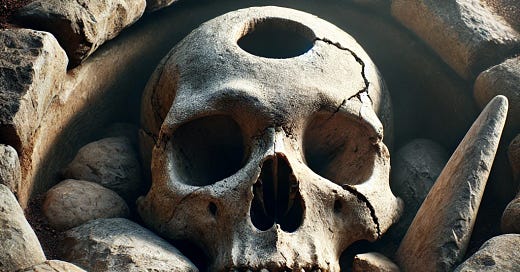In the quiet Scottish parish of Banchory-Devenick, a mysterious skull was unearthed from an ancient stone cist in 1822. Unlike typical skeletal remains, this skull bore a striking feature—a circular hole on its crown, approximately an inch in diameter. The discovery, preserved by the Society of Antiquaries of Scotland, raises an unsettling question: Was this a case of ancient murder, a brutal battlefield injury, or a ritual execution carried out by the enigmatic Picts?
The Discovery of the Skull
The skull was found buried in a stone cist—a type of small stone-built coffin—alongside flint flakes arranged carefully in heaps. The presence of these flints, likely meant for making weapons or tools, indicates that the burial was intentional and likely held significant meaning. The wound itself appears to have been inflicted by a stone axe, suggesting an act of violence.
The skull was noted to be small and fragile, belonging to a young adult male. Given the time period and burial context, this find connects to early Scottish societies, possibly dating back to the Pictish era (circa 300–900 AD) or even earlier Bronze Age communities.
Theories on the Cause of Death
Several possible explanations arise when examining how this individual met his end.
1. Battlefield Death or Execution of a Warrior?
One theory suggests that this young man was a warrior who fell in combat. Given that arrowheads, swords, and other weaponry have been found in the area, it is possible that he died in a skirmish or larger battle. If the wound was caused by an axe during battle, his remains might have been interred as a form of honor.
However, the wound being a clean, circular hole rather than a shattering blow suggests something more deliberate. If this were a battlefield injury, we would expect fractures or more irregular damage rather than a precise, singular hole. This raises the possibility that he was executed rather than killed in combat.
2. Human Sacrifice or Ritual Execution?
Ancient societies, including the Picts, have been linked to ritualistic practices, some of which may have involved human sacrifice. The presence of a circular wound in the skull is reminiscent of known ritual killings in other cultures, where a precise blow to the head was used as a form of offering to the gods.
Moreover, the careful placement of the body, alongside burial items like flint flakes, suggests that his death was meaningful in a ritualistic sense. Some scholars speculate that he could have been sacrificed to appease deities, as was common in Celtic traditions.
3. Trepanation: Ancient Surgery or a Failed Healing Attempt?
Trepanation—the practice of drilling or cutting a hole in the skull—was surprisingly common in ancient times. This procedure was performed for medical or spiritual reasons, often to relieve pressure from brain injuries or as a means of “releasing evil spirits.”
If this hole was created as part of a surgical procedure, the skull would typically show signs of healing around the edges. Unfortunately, this skull was fragile and incomplete, making it difficult to determine whether the wound was inflicted before or after death. If this was an unsuccessful trepanation, it could mean the individual was subjected to an early form of surgery but did not survive.
The Broader Context: Pictish Death Rituals and Mysticism
The Picts, who inhabited northern and eastern Scotland, remain shrouded in mystery due to their lack of written records. However, archaeological discoveries suggest they practiced elaborate burial customs, sometimes involving symbolic objects and careful placement of remains.
The presence of flint flakes in the burial cist might symbolize weapons for the afterlife, or they may have been part of a funeral rite. If this individual was ritually executed, his death could have been a sacrifice meant to ensure protection, fertility, or prosperity for the tribe.
A Final Mystery
While we may never fully determine whether this skull belonged to a warrior, a sacrificed individual, or a victim of an early surgical attempt, one thing is clear: his death was significant enough to warrant a careful burial. Unlike hastily disposed bodies of common criminals, this young man was placed with care, suggesting he was important to his people—either in life or in death.
What do you think? Was this an execution, a medical procedure gone wrong, or something even more mysterious?





